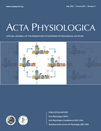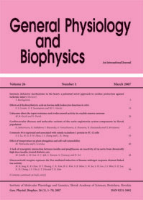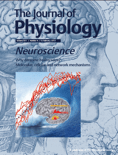
PFLUGERS ARCHIV-EUROPEAN JOURNAL OF PHYSIOLOGY
Scope & Guideline
Unveiling the Complexities of Life Through Research
Introduction
Aims and Scopes
- Molecular and Cellular Physiology:
The journal focuses on the mechanisms of cellular processes, including ion channel dynamics, signaling pathways, and metabolic regulation, contributing to a deeper understanding of how these processes affect organismal physiology. - Systemic Physiology and Pathophysiology:
PFLUGERS ARCHIV examines physiological functions across systems, studying the integration and regulation of body systems under normal and pathological conditions, such as cardiovascular, renal, and respiratory physiology. - Innovative Methodologies:
The journal encourages the use of cutting-edge techniques in physiology, including optogenetics, computational modeling, and advanced imaging techniques, to explore physiological phenomena. - Translational Research:
There is a strong emphasis on studies that translate basic physiological research into clinical applications, highlighting the relevance of physiological insights for understanding diseases and developing therapeutic strategies. - Neurophysiology and Behavior:
Research exploring the interplay between physiological processes and behavioral outcomes, particularly in areas such as pain, stress responses, and sensory processing, is a core focus of the journal.
Trending and Emerging
- Role of Gut-Brain Axis and Metabolism:
There is a growing interest in the interactions between gut microbiota, metabolic processes, and brain function, underscoring the importance of the gut-brain axis in health and disease. - Hypoxia and Oxygen Sensing Mechanisms:
Research on the physiological responses to hypoxia and the mechanisms of oxygen sensing is increasingly prominent, linking to areas such as cardiovascular health, metabolic disorders, and environmental physiology. - Advancements in Optogenetics and Neural Control:
The application of optogenetic tools to manipulate and study neural circuits is on the rise, providing insights into neuronal activity and its physiological implications in health and disease. - Non-coding RNAs in Physiology and Disease:
Investigations into the roles of non-coding RNAs in regulating physiological processes and their implications in various diseases are gaining traction, reflecting a trend towards molecular-level insights. - Impact of Lifestyle Factors on Physiological Health:
Research exploring how lifestyle factors, such as exercise, diet, and environmental influences, affect physiological functions and their implications for chronic diseases is increasingly represented.
Declining or Waning
- Traditional Pharmacological Studies:
Research centered on classical pharmacological approaches, such as drug mechanisms and effects on isolated tissues, is less frequently published, with a shift towards more integrative and complex physiological studies. - Basic Electrophysiology without Clinical Relevance:
While electrophysiological studies remain important, those lacking clear clinical implications or translational relevance appear to be waning, as the journal shifts towards studies that connect basic science with health outcomes. - Descriptive Studies of Physiological Processes:
There has been a noticeable decrease in purely descriptive studies that do not incorporate mechanistic insights or novel methodologies, reflecting a trend towards hypothesis-driven research. - Studies Lacking Interdisciplinary Approaches:
Research that does not incorporate interdisciplinary methodologies or collaborations, especially those that do not integrate molecular biology with systemic physiology, is less frequently represented.
Similar Journals

JOURNAL OF MUSCLE RESEARCH AND CELL MOTILITY
Pioneering Research in Muscle Science and Cellular MovementJOURNAL OF MUSCLE RESEARCH AND CELL MOTILITY, published by Springer, is a premier journal dedicated to advancing our understanding of muscle biology and cellular motility. With an ISSN of 0142-4319 and an E-ISSN of 1573-2657, this journal stands out in the fields of biochemistry, cell biology, and physiology, proudly holding a Q2 ranking in each of these categories as per 2023 metrics. Covering significant developments from its inception in 1963 to its anticipated contributions through 2024, this journal serves as a vital platform for researchers and professionals to disseminate their findings and insights globally. Although it does not currently offer open access, its robust academic rigor and relevance are evident from its Scopus rankings, making it a crucial resource for those invested in the biological sciences. With a focus on original research articles, reviews, and methodological advancements, the journal fosters innovative collaborations and discussions within the scientific community, making it an invaluable addition to any researcher’s library.

CELLULAR PHYSIOLOGY AND BIOCHEMISTRY
Showcasing Breakthroughs in Cellular PhysiologyCellular Physiology and Biochemistry is a premier Open Access journal published by the prestigious Cell Physiol Biochem Press GmbH & Co, dedicated to advancing research in the fields of physiology, biochemistry, and molecular biology. Since its inception in 1987 and transitioning to an Open Access model in 2013, the journal has established itself as a vital resource for the dissemination of high-quality research and reviews, showcasing innovative methodologies and groundbreaking findings in cellular processes. With an impressive ranking in the 2023 Scopus category as Q2 in Physiology and a robust percentile of 61, Cellular Physiology and Biochemistry is committed to fostering academic dialogue among researchers, professionals, and students alike. This journal not only provides unrestricted access to its articles, but also promotes the global sharing of knowledge, which is essential for the advancement of our understanding in these vital scientific areas. The journal's editorial team is dedicated to ensuring the highest standards of academic rigor and relevance, making it an indispensable addition to the libraries of those engaged in the life sciences.

JOURNAL OF INSECT PHYSIOLOGY
Decoding the Complexities of Insect PhysiologyThe Journal of Insect Physiology, an esteemed publication by Pergamon-Elsevier Science Ltd, stands at the forefront of the study of insect biology and physiology. Established in 1957 and set in the United Kingdom, this journal has consistently contributed to advancing our understanding of the intricate physiological processes of insects throughout its converged years ending in 2024. With an impressive impact factor that solidifies its reputation, it ranks in the 1st quartile for Insect Science and the 2nd quartile for Physiology as per the 2023 metrics. The journal's Scopus rankings also reflect its influence, boasting a notable position in both Agricultural and Biological Sciences and Biochemistry, Genetics, and Molecular Biology. Although currently not open access, it provides researchers and professionals with invaluable insights and groundbreaking research essential for the field. With its comprehensive scope, the Journal of Insect Physiology is dedicated to fostering scientific dialogue and innovation, making it an indispensable resource for scholars and students alike.

Acta Physiologica
Innovative Insights into Physiological MechanismsActa Physiologica is a premier, peer-reviewed journal published by WILEY, dedicated to the dissemination of high-quality research across the field of physiology. With an impressive impact factor reflective of its Q1 category ranking in Physiology for 2023, this journal is a vital resource for researchers, professionals, and students alike, seeking to explore the complexities of biological systems. The journal is indexed with a commendable Scopus rank of #18 out of 193 in its category, placing it within the top 10% of its field, which underscores its influence and citation frequency within the academic community. Acta Physiologica publishes a variety of articles that address fundamental physiological concepts, innovative methodologies, and cross-disciplinary research. With its open access options, the journal ensures that cutting-edge knowledge is readily accessible, fostering an environment of collaboration and advancement in the study of physiology. Spanning from 2006 to 2024, the journal continues to be at the forefront of physiological research and education, encouraging the global sharing of knowledge through its comprehensive content.

GENERAL PHYSIOLOGY AND BIOPHYSICS
Driving Research in Vital Scientific DisciplinesGENERAL PHYSIOLOGY AND BIOPHYSICS, published by AEPRESS SRO, is a pivotal journal in the fields of biophysics and physiology, dedicated to advancing knowledge and fostering research in these increasingly vital disciplines. Established in 1983 and set to converge in 2024, the journal provides a platform for scholarly articles that explore the intricate relationships between biological systems and physical principles. Its current category quartiles include Q3 in Biophysics and Q4 in Physiology, demonstrating a growing influence among researchers, with current Scopus ranks reflecting its commitment to quality and relevance. Despite not being an open-access publication, the journal remains a valuable resource for professionals and students aiming to stay informed on the latest discoveries and methodologies. By supporting interdisciplinary research and innovation, GENERAL PHYSIOLOGY AND BIOPHYSICS plays a crucial role in shaping the understanding of complex biological interactions and applications in medicine.

KOREAN JOURNAL OF PHYSIOLOGY & PHARMACOLOGY
Illuminating pathways in drug action and physiological understanding.Welcome to the Korean Journal of Physiology & Pharmacology, a pivotal academic platform dedicated to advancing the disciplines of physiology and pharmacology. Published by the esteemed Korean Journal of Physiology & Pharmacology, this journal has been disseminating valuable research findings since its inception in 1997 and continues to be a critical resource for researchers, professionals, and students in South Korea and beyond. With an ISSN of 1226-4512 and E-ISSN of 2093-3827, it offers insights into various aspects of drug action and physiological mechanisms. Although this journal currently does not subscribe to Open Access, it plays a vital role in bridging the gap between experimental and clinical studies, receiving commendations for its quality. In the 2023 Scopus rankings, it is notably positioned in the Q3 quartile for Pharmacology and Q4 for Physiology, reflecting its commitment to excellence. As the journal converges towards its comprehensive coverage in 2024, it remains a cornerstone for those looking to engage deeply with critical developments in these fields.

FISH PHYSIOLOGY AND BIOCHEMISTRY
Advancing Understanding of Fish PhysiologyFISH PHYSIOLOGY AND BIOCHEMISTRY, published by Springer, is a leading journal in the fields of aquatic science, biochemistry, and physiology, with an impressive trajectory since its inception in 1986 and continuing through 2024. Operating from the Netherlands, this journal serves as a vital platform for researchers, professionals, and students alike, showcasing innovative studies that explore the physiological and biochemical aspects of fish, contributing significantly to our understanding of aquatic ecosystems and their inhabitants. With a robust impact factor reflected in its Q1 status in Aquatic Science and notable rankings in other relevant categories, FISH PHYSIOLOGY AND BIOCHEMISTRY maintains a strong scholarly influence, evidenced by its Scopus ranking within the top quartiles of various biological sciences disciplines. While the journal does not currently offer open access options, it remains a cornerstone for advancing knowledge and fostering collaboration within the community dedicated to aquatic biology and related fields.

Journal of Physiological Sciences
Exploring the Depths of Physiological KnowledgeThe Journal of Physiological Sciences, published by BMC, stands as a prominent platform for the advancement of research in the field of physiology. Based in Japan, this open-access journal (ISSN: 1880-6546, E-ISSN: 1880-6562) is committed to disseminating high-quality scientific articles that explore various facets of physiological functions and mechanisms. With a 2023 Scopus ranking placing it within the 41st percentile in the category of Physiology, it is recognized for contributing significant insights that bridge basic and applied physiological research. The journal maintains a Q2 quartile ranking within its category, highlighting its impact within the scientific community. Researchers, professionals, and students are encouraged to engage with cutting-edge studies published from 2006 to 2024, fostering an environment of knowledge accessibility and scientific collaboration. The journal not only serves as a vital resource for those involved in physiological research but also promotes broader understanding and application of physiological principles across various health and science sectors.

JOURNAL OF PHYSIOLOGY-LONDON
Elevating Research in Physiology Since 1878JOURNAL OF PHYSIOLOGY-LONDON, published by WILEY, stands as a prestigious beacon in the fields of Physiology and Sports Science. Established in 1878, this journal has a rich history of disseminating crucial research findings and advancing scientific knowledge, continuing its impact into the present day with an anticipated convergence in 2024. Recognized for its excellence, it ranks in the Q1 category for both Physiology and Sports Science in 2023, cementing its position within the top echelons of academic publications. With a Scopus rank of #26 out of 193 in the Biochemistry, Genetics and Molecular Biology _ Physiology category, the journal boasts an impressive 86th percentile, reflecting its high-quality contributions to the scientific community. Although not open access, its extensive archive and reputation ensure that it remains a vital resource for researchers, professionals, and students eager to stay at the forefront of physiological science. For those looking to deepen their understanding of physiological mechanisms and their applications, the JOURNAL OF PHYSIOLOGY-LONDON is an indispensable resource.

JOURNAL OF GENERAL PHYSIOLOGY
Connecting Researchers to the Heart of PhysiologyJOURNAL OF GENERAL PHYSIOLOGY, published by Rockefeller University Press, is a leading peer-reviewed journal that has been at the forefront of physiological research since its inception in 1918. With an ISSN of 0022-1295 and an E-ISSN of 1540-7748, this esteemed journal maintains an impressive Q1 ranking in the field of Physiology, reflecting its high-quality contributions to both the basic and applied aspects of physiology. Regularly cited in the scientific community, it ranks 70th out of 193 in the category of Biochemistry, Genetics, and Molecular Biology, showcasing its significant impact within academic circles. The journal publishes original research, reviews, and commentaries, aiming to advance the understanding of physiological mechanisms and their implications across various biological systems. Although not Open Access, the journal remains a vital resource for researchers, professionals, and students dedicated to exploring the depths of cardiopulmonary function, neurophysiology, and cellular biochemical processes. The JOURNAL OF GENERAL PHYSIOLOGY continues to serve as a critical platform for disseminating innovative findings and fostering collaboration among scientists globally.